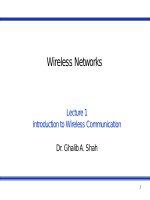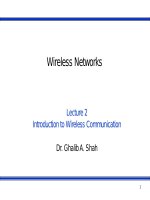Wireless networks - Lecture 25: 1st review
Bạn đang xem bản rút gọn của tài liệu. Xem và tải ngay bản đầy đủ của tài liệu tại đây (453.04 KB, 31 trang )
Wireless Networks
Lecture 25
1st Review
Dr. Ghalib A. Shah
1
Last Lecture
Cdma2000 introduction
New MAC and Physical layer features
Physical layer of cdma2000
Reverse Physical channels
New Network elements in cdma2000
► Packet Control Function (PCF)
► Packet Data Serving Node (PDSN)
Mobility Management
Handoff
► Intera-PCF
► Inter-PCF/Intra-PDSN
► Inter-PDSN
2
Lecture 1 - Introduction Part I
I.
II.
III.
IV.
V.
The Wireless vision
Radio Waves
Channel Capacity
Signal-to-Noise Ratio
EM Spectrum
3
Lecture 1 - Introduction Part II
Wireless Transmission
► Baseband signal, carrier frequency, fundamental
frequency
► antenna size must correspond to signal’s
wavelength
• 1 MHz signal few 100 m-s high antenna;
• 1 GHz signal few cm-s high antenna
Encoding/Modulation
Noises
► Thermal, Intermodulation, Crosstalk, Impulse
Losses/Gain
4
Lecture 3 – Introduction Part III
Multiplexing
Transmission Mediums
► Guided, Unguided
Propagation modes
► Ground wave, Sky wave, LOS
Multi-path propagation
► Reflection, Diffraction, Scattering
Fading
5
Lecture 4 – Error part I
Transmission Errors
Parity Check
Cyclic Redundancy Check
Block Error Code
6
Lecture 5 – Error part II
Block Codes
► Hamming
► BCH (Generalization of Hamming)
► Reed Solmon (Subclass of non-binary BCH)
ARQ
► Sliding window
► Go-back-N
7
Lecture 6 – Multiple Access (Part I)
FDMA
TDMA
CDMA
Random Access
► ALOHA
► Slotted ALOHA
► Reservation-based ALOHA
8
Lecture 7 – Multiple Access (Part II)
CSMA
► Versions of CSMA
► CSMA/CA
Spread Spectrum
► Frequency Hoping
► Direct Sequence
9
Lecture 8 – Evolution Part I
1G wireless cellular networks
► NMT
► AMPS
► TACS
2G cellular systems
►
►
►
►
GSM
IS-136
PDC
IS-95
10
Lecture 9 – Evolution Part II
2.5G
►
►
►
►
HSCSD
GPRS
EDGE
IS-95B
3G
► UMTS/W-CDMA
► CDMA2000
11
Specifications of 2.5G and 3G standards
Technology
Channel
BW
Duplex
Infrastructure Changes
New
Spectrum
New handsets
HSCSD
200 KHz
FDD
Software upgrade at BS
No
Yes, New headsets provide
57.6 kbps on HSCSD and
9.6 kbps on GSM
GPRS
200 KHz
FDD
New packet overlay at routers
and gateways
No
Yes, new GPRS sets work at
171.2 kbps, 9.6 kbps on
GSM, dualmode.
EDGE
200 KHz
FDD
New TX/Rx at BS, software
upgrade at BS, controller
No
Yes, new set work at 384
kbps on EDGE, GPRS at
144 kbps and GSM at 9.6
kbps, trimode
WCDMA
5 MHz
FDD
Completely new BS
Yes
Yes, new handsets work at 2
Mbps in WCDMA and rest
as above
IS95B
1.25 MHz
FDD
New software at BS
No
Yes, IS95B at 64kbps, IS
95A at 14.4 kbps and IS95
at 9.6 kbps
Cdma2000
1xRTT
1.25 MHz
FDD
New software at backbone, new
channel cards at BS, new packet
service node
No
1xRTT at 144 kbps and rest
as above. Older sets will
work.
Cdma2000
1xEV(DO/DV)
1.25 MHz
FDD
New software and cards upgrade
to 1xRTT
No
1xEV at 2.4 Mbps and as
above
Cdma2000
3xRTT
3.75 MHz
FDD
Backbone modifications and
channel cards at BS
May be
3xRTT at 2 Mbps and rest
as above
12
Lecture 10 Evolution III
Limitation of 3G
4G
►
►
►
►
►
►
Objectives
Issues
QoS
Security
Multimedia Service
Applications
Convergence of Cellular and WLAN
Billing Issue
13
Quality of Service (QoS)
Traffic generated by the different services will
not only increase traffic loads on the networks,
but will also require different quality of service
(QoS) requirements (e.g., cell loss rate, delay,
and jitter) for different streams (e.g., video,
voice, data).
Providing QoS guarantees in 4G networks is a
non-trivial issue where both QoS signaling
across different networks and service
differentiation between mobile flows will have to
be addressed.
14
Security
Security in wireless networks mainly involves
authentication, confidentiality, integrity, and
authorization for the access of network connectivity and
QoS resources for the mobile nodes flow.
The heterogeneity of wireless networks complicates the
security issue.
Dynamic reconfigurable, adaptive, and lightweight
security mechanisms should be developed.
AAA (Authentication Authorization Auditing) protocols
provide a framework for such suffered especially for
control plane functions and installing security policies in
the mobile node such as encryption, decryption and
filtering.
15
Lecture 11 – Cell Conept part I
Cellular Concept
Frequency Reuse
Locating co-channel cells
16
Lecture 12 – Cell Concept Part II
Channel Assignment Strategies
Handoff Strategies
► When to handoff
► 1G, BS based
► 2G or todays, Mobile-Assisted
Prioritizing Handoff
► Guard channels concept
► Queuing handoff requests
Practical handoff considerations
► Umbrella cell
► Cell dragging
17
Lecture 13 – Cell Concept Part III
Interference and system capacity
► Co-channel interference and capacity
► Adjacent channel interference and capacity
Channel Planning for Wireless System
18
Lacture 14 – Cell Concept Part IV
Trunking and Grade of Service
► Measuring Traffic Intensity
► Trunked Systems
• Blocked Calls Cleared
• Blocked Calls Delayed
► Erlang Charts
Improving Coverage and Capacity
►
►
►
►
Cell Splitting
Sectoring
Repeaters for Range Extension
Microcell Zone Concept
19
Lecture 15 - AMPS
AMPS introduction
System Overview
Call handling
Air interface
Supervisory signals
N-AMPS
20
Lecture 16 GSM
GSM Introduction
GSM System Architecture
GSM Network Areas
Specifications
Subscriber Services
Mobility
21
Lecture 17 – GPRS (part I)
Introduction to GPRS
GPRS Architecture
Registration and Session Management
Routing Scenario in GPRS
Channels Classification
22
PDP Context Activation
MS
SGSN
GGSN
Activate PDP Context Request
PDP type,PDP Address
QoS Requested,Access Point,…
Security Functions
Create PDP Context Request
PDP type,PDP Address
QoS Negotiated,Access Point,…
Activate PDP Context Accept
PDP type,PDP Address
QoS Negotiated,…
Create PDP Context Response
PDP type,QoS Negotiated,…
23
Lecture 18 – GPRS part II
GPRS Protocol Architecture
►
►
►
►
MS – BSS
BSS – SGSN
SGSN – GGSN
GGSN – PDN
GPRS Air Interface
Data Routing and Mobility
Uplink Data Transfer
Downlink Data Transfer
QoS in GPRS
24
Lecture 19 - IS-95
IS-136
CDMA/IS-95
Advantages
►
►
Drawbacks
►
Self-jamming, near-far problem,
IS-95 Forward Channels
►
►
►
►
Higher capacity, Improves voice quality (new coder), Less power
consumption (6-7 mW)
Privacy, graceful degradation
Pilot Channel
Sync Channel
Paging
Traffic
IS-95 Reverse Channels
25









